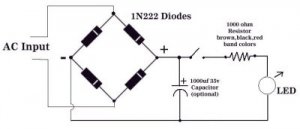Yep, it makes no difference in the order of which components are placed in a series circuit, AC or DC, since it's the total resistance (or impeadance) that determines the amount of current flowing.
Now, if there is an LED in the circuit, it is a diode, and it does block the flow of current in one direction and so you can use AC to power it. Basically, the LED acts as a half-wave rectifier and gets a positive (half cycle) pulse 60 or 50 times a second (dependent on the country you live in). It actually flickers that amount, but the light retention of the LED is such that you will not see the flicker.
Based on the above, you can use the ACC output of your Bachmann power supply, but you need to determin the output voltage and adjust the resistor value accordingly to maintain the proper current through the LED.
I don't want to add any confusion here, but I have used an LED to indicate when 120 VAC was turned on, I just used a large value, high wattage resistor. Anything different then either the resistor, the LED or both become toast, litterally.




I'm not recommending this, just pointing out that you can use low voltage AC to power an LED, and believe it or not, you cannot get the LED in backwards unless there is another diode or LED in the series circuit.



